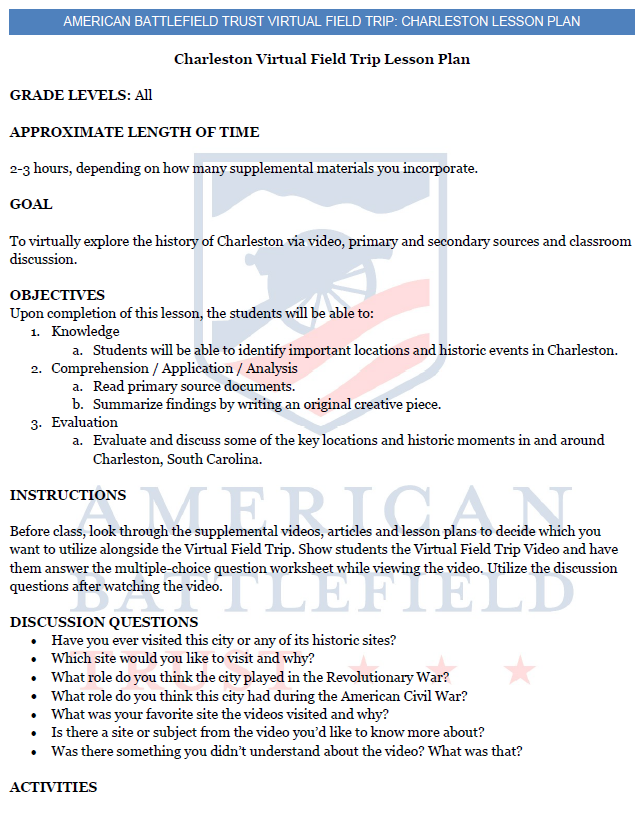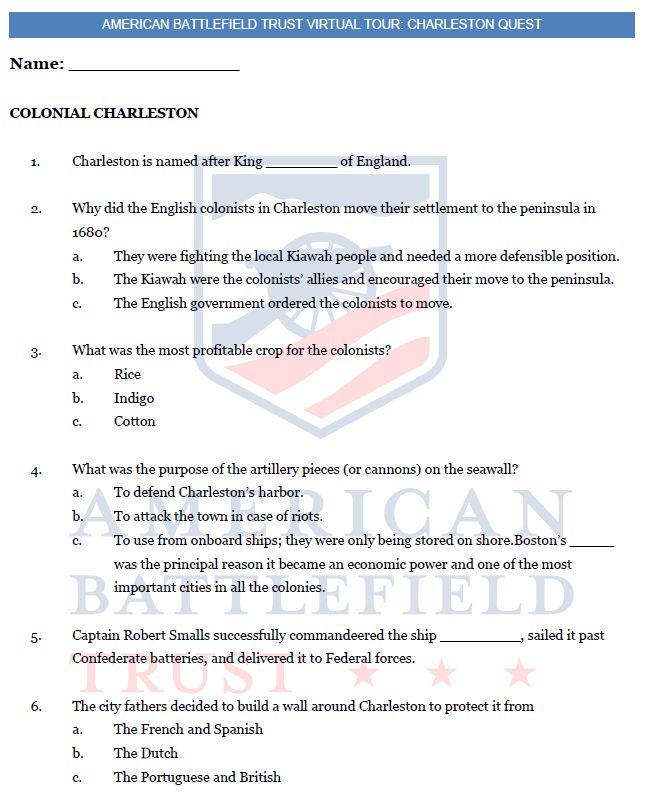
Charleston Virtual Field Trip Lesson Plan
A lesson plan for use in middle and high school classrooms.
If you're watching the Charleston Virtual Field Trip video with your students, it might be the perfect opportunity to explore even more of Charleston's history and culture! This lesson plan includes a range of resources about Charleston during the American Revolution, the Gullah Geechee culture, the start of the Civil War and the CSS H.L. Hunley's story and preservation.
This Lesson Plan can be used as a prepared resource by following this curriculum plan which aligns to NCSS and Common Core Standards.
This Lesson Plan's assets can also be used on their own as supplemental resources. The display format is prepared for easy access, exploring, and learning.
To virtually explore the history of Charleston via video, primary and secondary sources and classroom discussion.
Upon completion of this lesson, the students will be able to:
1. Knowledge
- Students will be able to identify important locations and historic events in Charleston.
2. Comprehension/Application/Analysis
- Read through primary source documents.
- Summarize findings by writing an original creative piece.
3. Evaluation
- Evaluate and discuss some of the key locations and historic moments in and around Charleston, South Carolina.
Check out the Lesson Plan Teaching Guide for more instructions on using the prepared Lesson Plan.
Lesson Plan Primary and Secondary Source Activity:
- Watch some or all the Charleston Virtual Field Trip video.
- Conduct a group discussion utilizing the discussion questions:
- Have you ever visited this town or any of its historic sites?
- Which site would you like to visit and why?
- What role do you think the city played in the Revolutionary War?
- What role do you think this city had during the American Civil War?
- What was your favorite site the videos visited and why?
- Is there a site or subject from the video you’d like to know more about?
- Was there something you didn’t understand about the video? What was that?
- Have the students complete the Video Question Quiz Worksheet.
- If the entire Virtual Field Trip video was watched, have the students complete all of it.
- If only some of the Virtual Field Trip video was viewed, have the students complete the relevant sections.
- Have the students complete the following exercise utilizing primary and secondary sources to influence a creative piece. In the piece, they should provide an accurate summary of the sources.
- Have students read and reference the below primary and secondary sources about events that happened in Charleston. Then, have them write a newspaper article about one of the events as though reporting on it from that historic era.
- Remember that there could be different perspectives on events and Charleston has been home to many people with different perspectives like patriot, loyalist, unionist, abolitionist, secessionist, Confederate and Union.
- American Revolution:
- South Carolina’s Secession:
- Start of the Civil War
- Complete an optional exercise.
OPTIONAL HOMEWORK/ASSESSMENT/ADDITIONAL ACTIVITIES:
Option 1:
Break students into small groups and assign one or two chapters of the video for each group to watch. Have the groups only watch their assigned sections. After viewing, have the small groups present what they learned to the class.
Option 2:
Have students research one aspect of the video that piqued their interest. They can prepare a 500-word paper or present their findings to the class in the form of an in-person or video presentation.
Option 3:
Gullah Geechee culture has shaped and inspired Charleston’s history. Language, music, sweetgrass baskets and unique foods are among its hallmarks. Students can choose an aspect of the Gullah Geechee culture to explore and make notes from their findings. Here are some resources to start with:
- The Gullah Geechee People – Discovering Legacy Of African Cultures
- What is Gullah Geechee food and how do you make it?
- Lowcountry Gullah-Geechee Culture · Hidden Voices: Enslaved Women in the Lowcountry and U.S. South · Lowcountry Digital History Initiative
- Sweetgrass - a historically important native grass for coastal conservation | Natural Resources Conservation Service
Have students create a piece of art to share their findings about Gullah Geechee culture and its history.
Option 4:
The 54th Massachusetts and the 1st South Carolina Infantry Regiments were among the first regiments of Black soldiers fighting for the Union cause during the Civil War. Read The 54th Massachusetts Infantry Regiment, Fort Wagner and the 54th Massachusetts Volunteer Infantry and 1st South Carolina Volunteer Infantry Regiment & The 33rd United States Colored Troops to learn about these black soldiers who fought in South Carolina during the Civil War. Explore and discuss how each regiment was recruited and the war experiences of the units. Use the following questions to guide the discussion:
- How was recruiting different and similar for each regiment?
- What military experiences were similar and different for each regiment?
- The Black soldiers in these regiments came from different regions and backgrounds. How might this have influenced their goals, hopes and service?
Option 5:
Have students read this excerpt from Edgar Allan Poe’s The Gold Bug along with secondary sources about Fort Moultrie: Sullivan's Island Battle Facts and Summary and History of Fort Moultrie. Divide the students into three groups and have them collect details and draw conclusions about what life at Sullivan’s Island would have been like during the Revolutionary War, the early 1800s (Poe’s era), and the Civil War. What would be similar? What changes? How does this help us consider the layers of history at locations?
Common Core State Standards- ELA & History/Social Studies
Grades 6-8
- Key Ideas and Details:
- CCSS.ELA-LITERACY.RH.6-8.2
- Determine the central ideas or information of a primary or secondary source; provide an accurate summary of the source distinct from prior knowledge or opinions.
- CCSS.ELA-LITERACY.RH.6-8.2
- Craft and Structure:
- CCSS.ELA-LITERACY.RH.6-8.6
- Identify aspects of a text that reveal an author's point of view or purpose (e.g., loaded language, inclusion or avoidance of particular facts).
- CCSS.ELA-LITERACY.RH.6-8.6
- Integration of Knowledge and Ideas:
- CCSS.ELA-LITERACY.RH.6-8.9
- Analyze the relationship between a primary and secondary source on the same topic.
- CCSS.ELA-LITERACY.RH.6-8.9
Grades 9-10
- Key Ideas and Details:
- CCSS.ELA-LITERACY.RH.9-10.2
- Determine the central ideas or information of a primary or secondary source; provide an accurate summary of how key events or ideas develop over the course of the text.
- CCSS.ELA-LITERACY.RH.9-10.2
- Craft and Structure:
- CCSS.ELA-LITERACY.RH.9-10.6
- Compare the point of view of two or more authors for how they treat the same or similar topics, including which details they include and emphasize in their respective accounts.
- CCSS.ELA-LITERACY.RH.9-10.6
- Integration of Knowledge and Ideas:
- CCSS.ELA-LITERACY.RH.9-10.9
- Compare and contrast treatments of the same topic in several primary and secondary sources.
- CCSS.ELA-LITERACY.RH.9-10.9
Grades 11-12
- Key Ideas and Details:
- CCSS.ELA-LITERACY.RH.11-12.2
- Determine the central ideas or information of a primary or secondary source; provide an accurate summary that makes clear the relationships among the key details and ideas.
- CCSS.ELA-LITERACY.RH.11-12.2
- Craft and Structure:
- CCSS.ELA-LITERACY.RH.11-12.6
- Evaluate the authors' differing points of view on the same historical event or issue by assessing the authors' claims, reasoning, and evidence.
- CCSS.ELA-LITERACY.RH.11-12.6
- Integration of Knowledge and Ideas:
- CCSS.ELA-LITERACY.RH.11-12.9
- Integrate information from diverse sources, both primary and secondary, into a coherent understanding of an idea or event, noting discrepancies among sources.
- CCSS.ELA-LITERACY.RH.11-12.9
Social Studies - National Council for the Social Studies
- Theme 1: Culture
- Theme 2: Time, Continuity, and Change
- Theme 3: People, Places, and Environments
- Theme 6: Power, Authority, And Governance
- Theme 8: Science, Technology, and Society
This Lesson plan
contains the following:
6 Activities | 52 Resources
Audience: Middle school | High school

